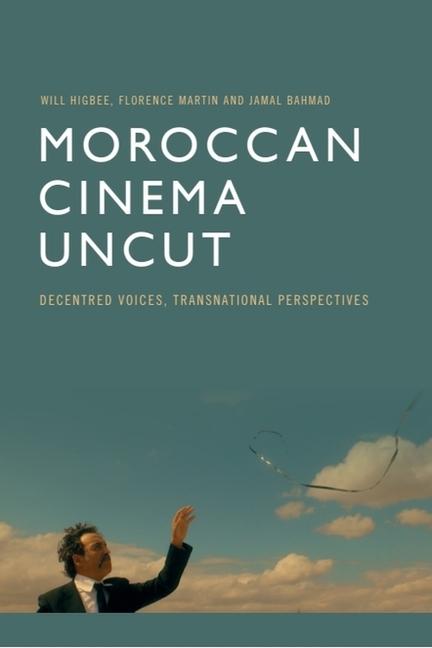
Zustellung: Di, 10.06. - Sa, 14.06.
Versand in 2 Wochen
VersandkostenfreiBestellen & in Filiale abholen:
This is the first book length study to consider the transnational dimension of Moroccan cinema. Over the past two decades, cinematic production has increased dramatically in Morocco, with Moroccan films leading at the domestic box office and being selected for prestigious international festivals such as Cannes and Berlin. And yet, Moroccan cinema remains little known outside of its national borders. This book asks why this might be and, in so doing, analyses the actual state of Moroccan national cinema beyond a post-colonial optic. Featuring interviews with filmmakers and key industry figures, such as Hicham Laari, Nadir Boumouch and Tala Hadid, the book explores Moroccan cinema's transnational reach through a focus on the cultural politics of international co-production, the role of international festivals as alternative distribution networks, piracy and digital disruption, film education and activism.
Will Higbee is a Professor of Film Studies at the University of Exeter.
Florence Martin is a Professor of French & Francophone Studies at Goucher College, US
Jamal Bahmad is an Associate Professor of English and Cultural Studies at Mohammed V University, Morocco.
Will Higbee is a Professor of Film Studies at the University of Exeter.
Florence Martin is a Professor of French & Francophone Studies at Goucher College, US
Jamal Bahmad is an Associate Professor of English and Cultural Studies at Mohammed V University, Morocco.
Inhaltsverzeichnis
Table of Contents
Acknowledgements
Introduction
Moroccan Cinema: A Story of Transnational Adaptation
Part I - Production From Above: Formal Networks
Chapter 1: Established Sites of Production At Home
1.1: Rabat and The CCM: The Institutional Centre
1.2: Ouarzazate: The Cinematic City
1.3: Tangier: The Artisanal Hub
1.4: Casablanca: The Industrial and Media Hub
Chapter 2: Transnational Crossings
2.1: The Politics of International Co-Production
2.2: The Rooted Transnationalism of Diasporic Filmmakers
2.3: Non-Western Production Networks
2.4: Co-Production Networks Between North Africa and Sub-Saharan Africa
Part II - Production From Below: Emerging Sites
Chapter 3: Alternative and Emerging Networks
3.1: Film Schools, Education and Training
3.2: Alternative Training Networks: Sahara Lab
3.3: Playing Around the System: Hicham Laari
3.4: Guerilla Filmmaking and Political Activism: Nadir Bouhmouch
Chapter 4: Diverse Voices
4.1: Amazigh Cinema: The Global Flow of Local Images
4.2: Transnational Contestations: Tala Hadid and Jawad Rhalib
4.3: Women's Cinema, Take One: Negotiating With the Establishment
4.4: Women's Cinema, Take Two: Circumventing the Establishment
Part III - Distribution Networks: Festivals Audiences and Markets
Chapter 5: Distribution and Exhibition Networks In Morocco
5.1: Festivals in the Kingdom
5.2: Piracy and the Crisis of Moroccan Distribution
5.3: Exhibition - The Trouble with Movie Theatres
5.4: Pan-Arab Transnational Exhibition: The Cinémathèque de Tanger
Chapter 6: The Transnational Moroccan Festival Network
6.1: The Transnational Festival Network
6.2: Europe: A-List Festivals, Markets and Film Funds
6.3: International Festivals Beyond Europe: the Gulf and Africa
6.4: Niche Festivals in Europe and Northern America
Chapter 7: Sales, Distribution and Digital Disruption - the Unrealised Transnational Reach of Moroccan Cinema?
7.1: Sales and Distribution Outside of Morocco
7.2: Selling Moroccan Cinema to a European Audience: Much Loved
7.3 Brave New World Or The Same Old Problems? Moroccan Cinema, Online Distribution and Digital Disruption
Conclusion
Transnational Moroccan Cinema: Of Bumblebees And Butterflies
References
Bibliography
Filmography.
Acknowledgements
Introduction
Moroccan Cinema: A Story of Transnational Adaptation
Part I - Production From Above: Formal Networks
Chapter 1: Established Sites of Production At Home
1.1: Rabat and The CCM: The Institutional Centre
1.2: Ouarzazate: The Cinematic City
1.3: Tangier: The Artisanal Hub
1.4: Casablanca: The Industrial and Media Hub
Chapter 2: Transnational Crossings
2.1: The Politics of International Co-Production
2.2: The Rooted Transnationalism of Diasporic Filmmakers
2.3: Non-Western Production Networks
2.4: Co-Production Networks Between North Africa and Sub-Saharan Africa
Part II - Production From Below: Emerging Sites
Chapter 3: Alternative and Emerging Networks
3.1: Film Schools, Education and Training
3.2: Alternative Training Networks: Sahara Lab
3.3: Playing Around the System: Hicham Laari
3.4: Guerilla Filmmaking and Political Activism: Nadir Bouhmouch
Chapter 4: Diverse Voices
4.1: Amazigh Cinema: The Global Flow of Local Images
4.2: Transnational Contestations: Tala Hadid and Jawad Rhalib
4.3: Women's Cinema, Take One: Negotiating With the Establishment
4.4: Women's Cinema, Take Two: Circumventing the Establishment
Part III - Distribution Networks: Festivals Audiences and Markets
Chapter 5: Distribution and Exhibition Networks In Morocco
5.1: Festivals in the Kingdom
5.2: Piracy and the Crisis of Moroccan Distribution
5.3: Exhibition - The Trouble with Movie Theatres
5.4: Pan-Arab Transnational Exhibition: The Cinémathèque de Tanger
Chapter 6: The Transnational Moroccan Festival Network
6.1: The Transnational Festival Network
6.2: Europe: A-List Festivals, Markets and Film Funds
6.3: International Festivals Beyond Europe: the Gulf and Africa
6.4: Niche Festivals in Europe and Northern America
Chapter 7: Sales, Distribution and Digital Disruption - the Unrealised Transnational Reach of Moroccan Cinema?
7.1: Sales and Distribution Outside of Morocco
7.2: Selling Moroccan Cinema to a European Audience: Much Loved
7.3 Brave New World Or The Same Old Problems? Moroccan Cinema, Online Distribution and Digital Disruption
Conclusion
Transnational Moroccan Cinema: Of Bumblebees And Butterflies
References
Bibliography
Filmography.
Produktdetails
Erscheinungsdatum
18. August 2020
Sprache
englisch
Seitenanzahl
288
Autor/Autorin
Jamal Bahmad, Will Higbee, Flo Martin
Verlag/Hersteller
Produktart
gebunden
Gewicht
581 g
Größe (L/B/H)
234/156/18 mm
ISBN
9781474477932
Bewertungen
0 Bewertungen
Es wurden noch keine Bewertungen abgegeben. Schreiben Sie die erste Bewertung zu "Moroccan Cinema Uncut" und helfen Sie damit anderen bei der Kaufentscheidung.










